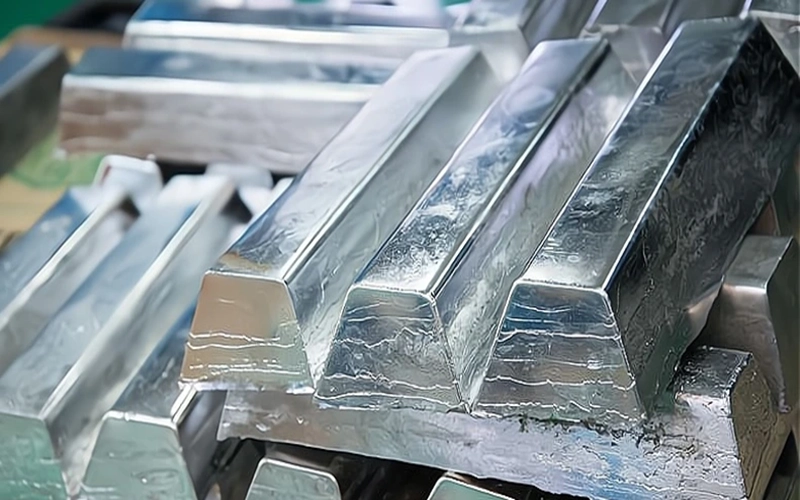Tin ingots are fundamental forms of tin metal, cast into standardized shapes for ease of handling, storage, and further processing. Tin (Sn), with atomic number 50, is a soft, silvery-white metal known for its malleability, ductility, and resistance to corrosion. These properties have made tin a valuable material throughout history, finding applications in various industries and playing a crucial role in technological advancements.
Production of Tin Ingots
The journey of tin ingot production begins with extracting tin ore, primarily cassiterite (SnO₂), from mineral deposits. Major tin-producing countries include China, Indonesia, Myanmar, and Peru. Once extracted, the ore undergoes several processes:
Concentration: The raw ore is crushed and washed to remove impurities, increasing the tin content.
Smelting: The concentrated ore is heated in a furnace with carbon, typically coal or charcoal. This process reduces the tin oxide to metallic tin:
SnO2+2C→Sn+2CO
Refining: The crude tin obtained from smelting may contain impurities such as iron, lead, or arsenic. Electrolytic refining or vacuum distillation is employed to achieve high-purity tin.
Casting: The purified tin is then poured into molds to form ingots. These ingots are typically rectangular blocks, but shapes can vary depending on specific industrial requirements.
Historical Significance
Tin ingots have played a pivotal role in human history, particularly during the Bronze Age (approximately 3300–1200 BCE). The alloying of tin with copper produces bronze, a material that marked a significant technological advancement due to its superior hardness and durability compared to pure copper. Archaeological discoveries, such as the tin ingots found at the Erme Ingot Site off the coast of Devon, England, highlight the extensive trade networks established to source and distribute tin. These ingots, dating back to before 1000 BCE, provide insight into early metallurgical practices and the economic importance of tin in ancient societies.

Applications of Tin Ingots
Tin ingots serve as the foundational material for various applications across multiple industries:
Soldering: Tin’s low melting point and excellent wetting properties make it ideal for solder, used extensively in electronics to join components.
Plating: Tin plating is employed to coat other metals, providing corrosion resistance and an attractive appearance. This is common in food packaging, where tin-coated steel cans prevent rusting and preserve contents.
Alloys: Beyond bronze, tin is alloyed with metals like lead to produce pewter, traditionally used for tableware and decorative items.
Chemicals: Tin compounds, derived from ingots, are utilized in various chemical processes, including the production of PVC stabilizers and glass coatings.
Tin ingots, though simple in form, are integral to numerous industrial processes and products that define modern life. From their historical significance in alloy production to their contemporary applications in electronics and coatings, tin ingots continue to be a vital material. Understanding their production, applications, and market trends offers valuable insights into the broader context of industrial development and economic fluctuations.
Tin ingots: Cast in the shape of a peck: Ingots require a second procedure of shaping, such as cold/hot working, cutting or milling to produce a useful final product. Additionally ingots (of less common materials) can be used as currency, or as a currency reserve as with gold bars.
Weight:
Between 25 to 30 kg

|
Chemical Composition % |
||||||||||||||
|
TIN INGOT |
Specification % |
|||||||||||||
|
Sn |
As |
Pb |
Sb |
In |
Fe |
Ni |
Bi |
Cu |
Al |
Zn |
Cd |
S |
||
|
Min |
Max 0.017 |
Max 0.036 |
Max 0.012 |
Max 0.01 |
Max 0.007 |
Max 0.005 |
Max 0.004 |
Max 0.01 |
Max 0.001 |
Max 0.001 |
Max 0.001 |
Max 0.001 |
||